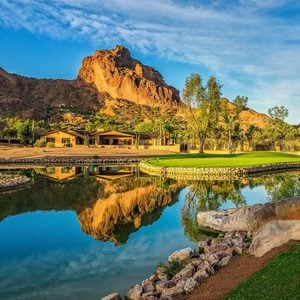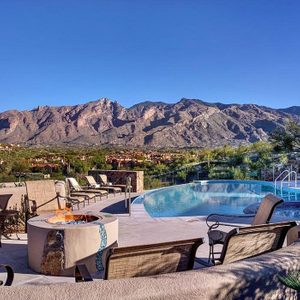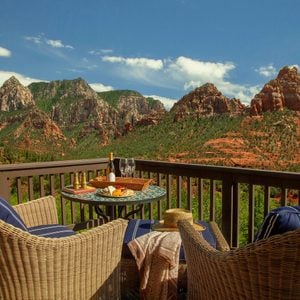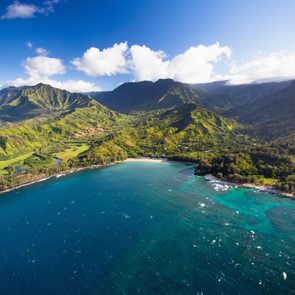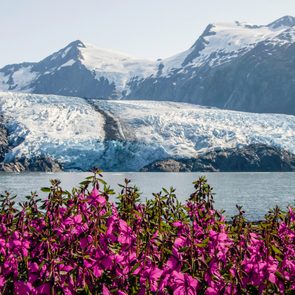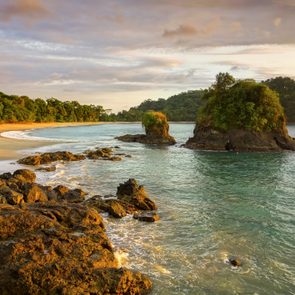The Best Time to Visit Arizona for Temperate Weather and Stunning Scenery
Updated: Mar. 30, 2023

State 48 is truly a year-round destination for sun and fun, but there's definitely a best time to visit Arizona, depending on where you plan to travel
Our editors and experts handpick every product we feature. We may earn a commission from your purchases.Learn more.
Arizona offers a unique blend of natural beauty, outdoor adventure, cultural experiences, world-renowned resorts and spas, and urban amenities that make for a great vacation destination for a wide range of travelers. There’s so much to see in each part of the state—for instance, this Arizona road trip takes you from the heart of the Sonoran Desert in Phoenix to the unparalleled views of the Grand Canyon, with plenty of sights to behold along your journey. As such, the best time to visit Arizona varies based on the part of the state you’re planning to visit, as you’ll find different climates spread throughout.
This is a state you’re going to want to explore. (I should know: I’ve lived in Phoenix for more than 20 years!) Thankfully, you don’t have to blow your entire travel budget in the process.
Looking for cheap places to travel? The South Rim of the Grand Canyon is an awe-inspiring and affordable family vacation idea. And if you know the best time to book a flight, the best time to book a hotel and the budget airlines that’ll get you there for less, you’ll have no problem exploring Arizona on a budget.
Get Reader’s Digest‘s Read Up newsletter for more travel, humor, cleaning, tech and fun facts all week long.
Why plan a trip to Arizona?
While the entire state is stunning, Arizona offers some of the most breathtaking natural landscapes in the United States, from the expansive Grand Canyon up north and the iconic red rocks of Sedona to the Sonoran Desert of Phoenix and Saguaro National Park down south. Many of these landscapes are ideal for hiking, biking and rock climbing.
And you don’t need to embark on a cheap beach vacation to take a dip or have an adventure on the water. You may think of Arizona as a vast desert, but there are plenty of water-based activities too—beyond the pools you’ll find at hotels and resorts. Raft the Colorado River, go tubing in the Salt River, enjoy boating and jet skiing at Lake Pleasant or Lake Powell, and take a dip in one of several hot springs.
Arizona also has a rich Native American history and culture—there are 22 federally recognized Tribes in the state—which you can experience through visits to various historical sites, festivals, galleries and museums.
The food scene features everything from celebrity chef–driven restaurants and five-star cuisine to tasty creations from taco trucks and hole-in-the-wall eateries. Of course, you’ll find plenty of Mexican and Southwestern options, but don’t overlook the global flavors talented chefs from other cities and countries have brought to state 48. In fact, Tucson is a UNESCO City of Gastronomy (the first city in the country to earn this designation), which honors the city’s culinary heritage dating back 4,000 years.
When is the weather the best in Arizona?
If you don’t like the weather where you are in Arizona, drive two hours in a different direction and it’ll probably be perfect. Seriously! When it’s too hot in Phoenix and Tucson, it’s usually the best time to visit Sedona and Flagstaff. And when it’s snowing in Sedona and Flagstaff, it’s usually a beautiful day down south. Truly, any time is the best time to visit Arizona.
If you’re in it for the sunshine, Arizona is truly one of the best places to travel. Phoenix sees about 300 sunny days a year (it’s the sunniest city in the nation), but even Flagstaff, which is farther north in the mountains, sees about 260 days of sunshine annually. And the average rainfall in Arizona is only 12.26 inches, making it one of the driest states in the country.
The best time to visit Arizona for the best weather depends on where you’re vacationing, though temperatures are most mild in spring and fall. In the winter, high temperatures range from the high 60s in Phoenix and Tucson to the high 50s in Sedona and low 40s in Flagstaff. Summer can be sweltering, with Phoenix and Tucson hitting an average high temp of 100 degrees—and above—and Sedona hovering at an average of 95 degrees; Flagstaff averages a more bearable high of around 69 degrees.
In spring, though, you can travel to any of those areas and feel comfortable, whether it’s a high of a dry 85 in Tucson, a wonderfully mild 75 degrees in Sedona or a cooler 59 degrees in Flagstaff. In the fall, the average high temperature may reach the high 80s in Phoenix and Tucson, but it’ll hover in the 60s and 70s in Flagstaff and Sedona, respectively.
Do watch out for summer monsoons in Phoenix, which happen between mid-June and the end of September, as those can produce higher humidity, heavy rain, lightning, hail, high winds, flash flooding and dust storms.
What is the most popular month to go to Arizona?
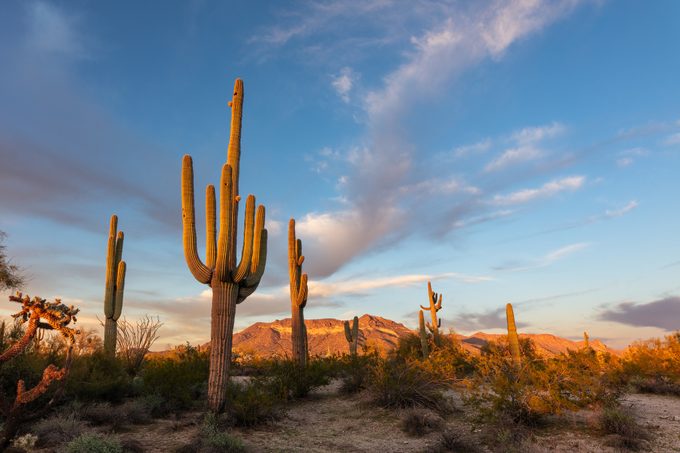
It’s always high season somewhere in Arizona, but the exact timing and location changes based on which city you’re visiting.
The best time to visit Phoenix and Scottsdale
The most popular time to visit Phoenix and Scottsdale is February through April, when Cactus League Spring Training baseball games are in full swing and the weather is absolutely gorgeous. This is also when Phoenix and Scottsdale host crowd-drawing annual events, like the Phoenix Open golf tournament and Barrett-Jackson car auction.
Of course, this is also when you’ll find the area at its busiest and most expensive. If you plan to visit in the spring, be sure to book a hotel or motel far in advance (and do the same with restaurants if you have your heart set on a specific dining experience).
Depending on where you’re headed, the high season may start even earlier. Take Phoenix, for instance. With folks in colder climates retreating to their second homes in the warm, sunny city when temperatures cool, Phoenix fills up from October through April.
The best time to visit Tucson
A couple hours south in Tucson, nary a room can be had during the first two weeks of February, when the world’s largest gem show takes place. Even outlying communities’ rooms fill up for this sparkly show.
Like Phoenix, Tucson also sees a lot of “snowbird” activity from October through April, as this is when part-time residents flee their snowy and cold primary residences in favor of a mild winter at their second homes.
The best time to visit Sedona and Flagstaff
Come summer, when temperatures can rise to an unbearable 110 degrees (and more) for several months in the Phoenix Valley and Tucson, head north to Sedona or Flagstaff. Here, you’ll find less-debilitating daytime temperatures between 80 and 90 degrees. (Though you’ll still need to pack the sunscreen.)
But Sedona’s best temperatures are generally from March to June and then again during the October and November shoulder season. It’s not uncommon to see a little snow from December through February, but it’s generally more of a dusting that melts off by noon the next day. Even in the chilliest months (January is the coldest), the average high temperature sits in the 40s and 50s, although it freezes at night.
Flagstaff is busy in the summer because it is much cooler than the desert communities and because of its proximity to some of Arizona’s iconic scenery (such as the Grand Canyon). But it also has stunning scenery for snow seekers and skiers in the winter thanks to Mount Humphreys, a 12,633-foot peak. (For reference, Flagstaff sits at around 7,000 feet elevation.)
When is the cheapest time to go to Arizona?
The best time to go to Arizona is unlikely to coincide with the least-expensive time to visit. In the summer, it’s common to find hotel deals of 30% to 40% off in Phoenix, Scottsdale and Tucson, but navigating the extreme heat will be your trade-off for this affordable four- and five-star luxury.
The least expensive time to visit Sedona is January and February or August—although “cheap” is a relative term for this small town. And Flagstaff rates are higher in the summer and on weekends during ski season, so avoid those time frames.
Book your stay in Arizona
Now that you’ve zeroed in on the best time to visit Arizona, it’s time to start looking at hotel options. These three are the best of the bunch, whether you’re popping in for a quick trip or booking an extended stay. (There’s no right amount of days to spend in the state, though if you have a packed itinerary or plan to travel from end to end, you may need more than a few days to see everything; a week gives you more wiggle room.)
If you’re headed to Phoenix, Mountain Shadows Resort Scottsdale is a must-stay spot. It lives in the shadow of the area’s iconic Camelback Mountain and offers a gorgeous pool and excellent golf.
Is Tucson more your speed? The historic Hacienda del Sol Guest Ranch Resort delivers southwestern charm in the foothills of the Santa Catalina Mountains, with 34 acres of natural desert landscape and beautiful botanical gardens.
For a more romantic stay among the famous Sedona red rocks and along the banks of the area’s meandering Oak Creek, choose L’Auberge de Sedona. And be sure to book a relaxing treatment at L’Apothecary Nature Spa while you’re there.
Sources:
- Heard Museum: “Arizona Indian Communities”
- Tucson City of Gastronomy: “UNESCO”
- Visit Arizona: “Weather”
- City of Flagstaff: “Community Overview”




















